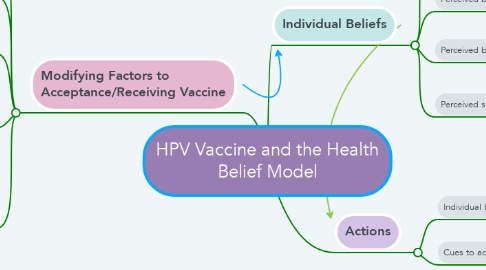
1. Modifying Factors to Acceptance/Receiving Vaccine
1.1. Age
1.1.1. Per CDC, recommended ages 11-12, so heavily relying on parents to make the decision
1.2. Gender
1.2.1. Per Koplas article, no difference in males versus female knowledge of vaccine, but females have higher uptake of the vaccine
1.3. Ethnicity
1.3.1. Vaccine for Children program offers free vaccines to American Indian/Alaskan Native
1.4. Socioeconomics
1.4.1. Cost of the vaccine can be up to $250 dollars
1.4.2. Lack of insurance
1.4.3. Programs that will cover HPV vaccine
1.5. Knowledge
1.5.1. Gaps in provider education
1.5.1.1. Study in Virginia showed that male providers were not as likely to recommend the vaccine as
1.5.1.2. In the same study, providers >50 years old recommended the vaccine less than younger providers did
2. Individual Beliefs
2.1. Perceived susceptibility to and severity of disease
2.1.1. Perceived threat
2.1.1.1. HPV infections
2.1.1.2. Cervical Cancers
2.2. Perceived benefits
2.2.1. Per CDC, most beneficial when <27 years old, due to likelihood of being exposed by then is high
2.3. Perceived barriers
2.3.1. Per CDC, if you wait until you are older than 15 years old, you will likely need three shots instead of two
2.4. Perceived self-efficacy
2.4.1. No history of cancer
2.4.2. Not sexually active
3. Actions
3.1. Individual behaviors
3.1.1. People who are not sexually active do not think that they need it
3.2. Cues to action
3.2.1. College physicals provide the opportunity for providers to educate on HPV vaccine at a high risk period in life
